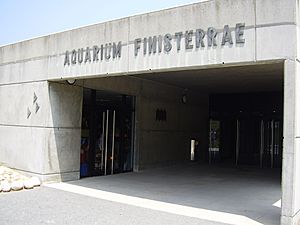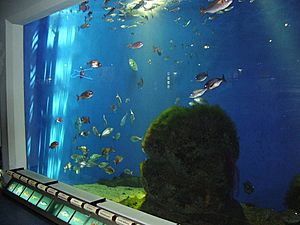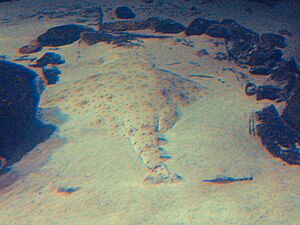Aquarium Finisterrae facts for kids

Aquarium entrance
|
|
| Date opened | June 5, 1999 |
|---|---|
| Location | A Coruña, Galicia, Spain |
| Coordinates | 43°23′02″N 8°24′35″W / 43.3840°N 8.4098°W |
| No. of species | >600 |
| Volume of largest tank | 4,400,000 litres (1,200,000 US gal) |
The Aquarium Finisterrae is a cool aquarium in A Coruña, Galicia, Spain. Its name means 'Aquarium of the End of the World'! It's a fun place where you can learn all about marine biology (the study of sea life) and oceanography (the study of oceans). The aquarium also works hard to protect ocean animals and their homes.
The city of A Coruña opened the aquarium on June 5, 1999. It is located right on the coast of A Coruña. You can find it between the Domus (museum) and the famous Tower of Hercules. Some of its outdoor pools even get water directly from the Atlantic Ocean!
Exploring the Aquarium Finisterrae
The Aquarium Finisterrae has many exciting areas to explore. Each part offers a unique way to discover the wonders of the ocean.
Sala Maremágnum: Atlantic Ocean Wonders
The Sala Maremágnum is a big room all about the Atlantic Ocean. It's home to more than 600 different kinds of Atlantic sea creatures! This room has many interactive exhibits. For example, the Charca de las caricias (Stroking Pool) lets you gently touch some marine animals.
You can also find exhibits about how to tie nautical knots, what different fish smells are like, and even how much water a sponge can hold. There are also tanks with beautiful jellyfish, tiny sea horses, and a small display of ancient sea fossils. The main tank at the entrance often features a special animal that changes from time to time.
Five large aquariums in this room show different parts of the Galician coast. You can see animals that live near cliffs or on the continental shelf. These tanks are home to interesting creatures like morays, congers, lophii, groupers, and John Dory. The aquarium also has a special nursery called BioHut for baby marine organisms.
Sala Humboldt: Changing Exhibits
The Sala Humboldt is a special room for temporary exhibits. These exhibits change about every two years. For example, one of the first exhibits here showed amazing fish from the Caribbean Sea.
Sala Nautilus: Under the Sea Adventure
Step into the Sala Nautilus and feel like you're deep underwater! This room looks like Captain Nemo's study from the famous book Twenty Thousand Leagues Under the Seas by Jules Verne. You can look through 48 windows into a huge pool that holds 4.4 million liters of water.
This giant tank is home to 700 fish from 34 different species. You'll see large sand sharks, amberfish, and ocean sunfish. There are also many types of sharks like school sharks, angel sharks, and spiny dogfish. You might also spot fish common to the Galician coast, such as sea bass and huge turbots.
One of the most popular residents is Gastón, a male sand shark who is 3 meters long and weighs 100 kg! He arrived on May 24, 2006, and lives with a female sand shark named Hermosa. The room is filled with items from the 1800s, like old maps and scientific tools, making you feel like you're truly in Captain Nemo's world. Special music plays to complete the underwater atmosphere.
Outdoor Areas and Marine Life
The Aquarium Finisterrae also has exciting outdoor areas where you can see more animals and learn about the ocean.
Terraza Exterior: Fishing and History
On the Terraza exterior (Outdoor Terrace), you can see art about fishing. There's even a real fishing boat cabin called María del Carmen. You can also see the anchor from the oil tanker Mar Egeo. This ship ran aground in 1992, causing an oil spill.
Paraíso Marino: Seal Home
From the terrace, you can go to the Paraíso Marino (Marine Paradise). This area gets its water directly from the sea. It's home to three male seals named Altair, Gregor, and Hansi.
Jardín Botánico: Coastal Plants
If you look to the left of the aquarium building, you'll find a Jardín Botánico (Botanical Garden). This garden features many different plants that grow along the Galician coast.
Piscinarium: More Seals
The Piscinarium is another area where you can see seals. Six female seals live here: Bine, Deneb, Lara, Paula, Petra, and Vega.
Octopus' Garden: Smart Cephalopods
Finally, the Octopus' Garden is a special place to watch and learn about the amazing behavior of octopuses. These creatures are known for being very smart!
See also
 In Spanish: Aquarium Finisterrae para niños
In Spanish: Aquarium Finisterrae para niños




